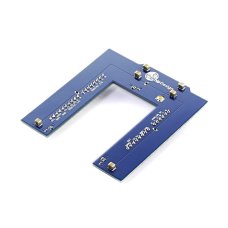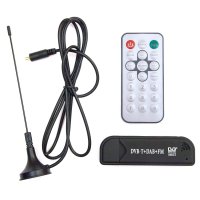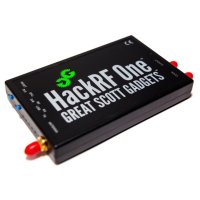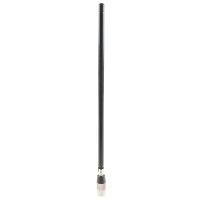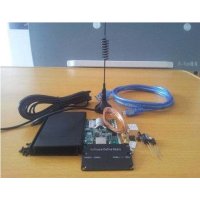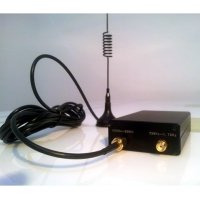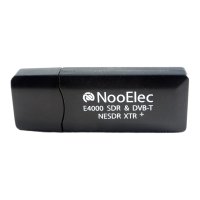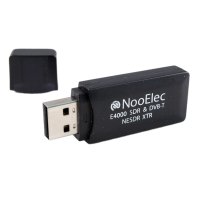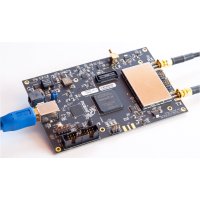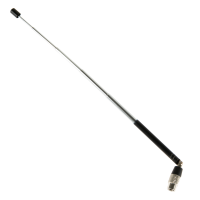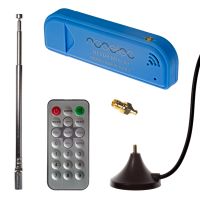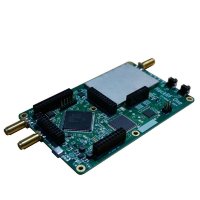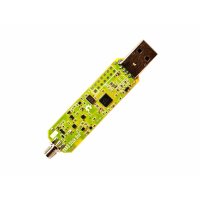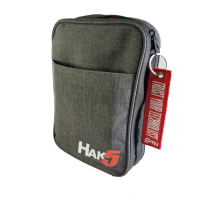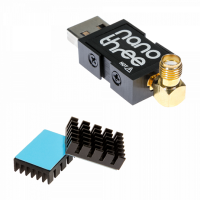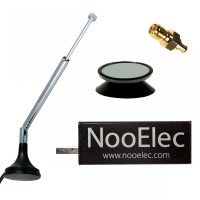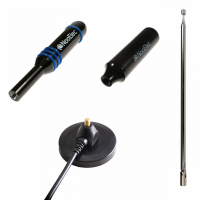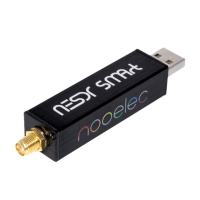ChipDesign's tunable antenna for mobile devices consists of a low-profile electronically-tunable electrically-small (18.5 cm long) slot antenna, which allows for improved receiver selectivity1. The tunable antenna can be used in conjunction with software defined radios (SDRs) such as for example the Ettus/NI USRP, the FlexRadio, the FUNcube Dongle, the HackRF and the RTL-SDR.
Features:
Band coverage:
-
- Well-matched (dB20(|S11|) < -10 dB, VSWR < 1.9) frequency bands are the 700 MHz, 866 MHz (ISM), 900 MHz, 1227 MHz (GPS L2), 1800 MHz, 1900 MHz, and 2100 MHz band. For the cellular bands, the full TX band, the duplex gap, and the full RX band are covered, allowing contiguous and non-contiguous intra-band CA with an instantaneous bandwidth up to 100 MHz, if applicable.
- Poorly-matched (dB20(|S11|) < -6 dB, VSWR < 3) frequency bands are the 433 MHz (ISM) and 450 MHz band for the Seeed version.
- The presence of the test hardware affects the return loss, as any efficient antenna is sensitive to its surrounding. Return loss measurements were done with the tunable antenna plugged into an Arduino Due and a Seeeduino Lotus micro-controller board, and the results can differ by as much as 100 MHz for the same bias settings. At the edges of the tunable frequency range - i.e. at 400 - 433 MHz and 2.45 - 2.6 GHz, differences in return loss can exist, which can not be compensated anymore by biasing the RF varactor diodes differently.
- Directivity: The full-space radiating version is recommended for IoT devices and tablets, whereas half-space radiating version, currently under development, is recommended for smartphones in order to meet the SAR specification. A λ0/2 full-space radiator has a directivity of 1.6 dBi, whereas λ0/2 half-space radiator has a directivity of 10log10(π) ≈ 5 dBi.
- Efficiency: TBD. The bandwidth and efficiency of electrically-small antennas with sufficient instantaneous bandwidth are bounded by the Chu-Harrington limit.
- Programming: The frequency band can be programmed using three PWM outputs of Arduino micro-controller boards, such as the Arduino Due or the Seeeduino Lotus, or 5 V Arduino shield compatible mbed2 micro-controller boards, such as the u-blox C027.
Tunable elements: 3 RF varactor diodes integrated in the radiating aperture for improved antenna match tuning. The tuning time is limited by the RC constant of the low pass filter on the PWM outputs. The RF varactor diodes do generate spurious emission.
Specification:
Seeed version - Test hardware influencing the antenna match: Seeeduino Lotus micro-controller board and 10 cm U.FL to SMA adapter.
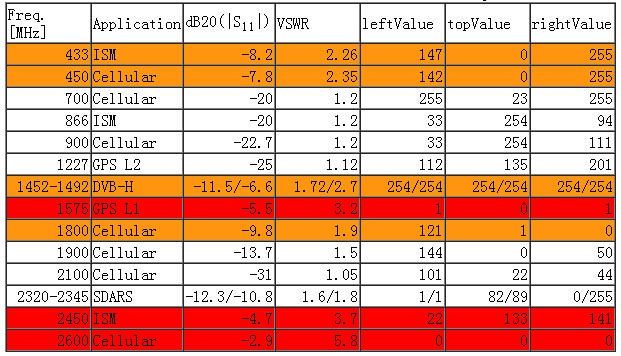
1. UWB antennas, such as the log-periodic and the Archimedean spiral antenna, are electrically-large and therefore do not allow for MIMO on the handset, and offer no selectivity.↩
2. 3.3 V mbed micro-controller boards will require 3.3 V to 5 V level shifters to be inserted to bias the varactors up to 5 V and cover the entire tunable frequency range of the tunable antenna.↩
If you have any technical problem, please contact info [at] chipdesign.be.
Antenna - Software Defined Radio
- Product Code: Seeed-Antenna-SDR
- Reward Points: 44
- Availability: In Stock
-
रo 4,432.00
- Price in reward points: 4432
-
- 90 or more रo 4,111.00
Related Products
SDR Receiver - RTL2832U+R820T2 - USB Stick version with Antenna and Remote
Watch and record digital terrestrial TV on PC or Laptop Watch DVB-T digital TV and listen to DAB..
रo 1,445.00
HackRF One, an open source SDR platform
HackRF One from Great Scott Gadgets is a Software Defined Radio peripheral capable of transmission o..
रo 28,318.00 रo 29,262.00
Antenna Telescopic - ANT500
75 MHz to 1 GHz telescopic antenna ANT500 is a telescopic antenna designed for operati..
रo 2,827.00
SDR RTL2832 + R820T - DIY Kit
Do-it-Yourself SDR to be soldered Kit ! The receiver take RTL2832U + R820T programs , taking adv..
रo 2,785.00 रo 3,000.00
SDR RTL2832 + R820T
SDR RTL2832 + R820T The receiver take RTL2832U + R820T programs , taking advantage of the Q chan..
रo 2,950.00
SDR XTR+ Tiny Extended-Range TCXO-Based SDR & DVB-T USB Stick (RTL2832U + E4000) with Antenna and Remote Control
SDR XTR+ tiny SDR & DVB-T USB set, including GPS-rated +/- 0.5PPM TCXO, quality telescopic antenna a..
रo 4,798.00
NooElec NESDR XTR Tiny SDR and DVB-T USB Stick (RTL2832U + E4000) with Antenna and Remote Control
SDR XTR Tiny SDR & DVB-T USB set, including quality telescopic antenna and remote control. Genuine E..
रo 4,531.00
bladeRF X40
Out of the box, the bladeRF can tune from 300MHz to 3.8GHz without the need for extra boards. Throug..
रo 69,135.00
Antenna Telescopic - ANT700
300 MHz to 1.1 GHz telescopic antenna ANT700 from Great Scott Gadgets is a telesc..
रo 2,356.00
NooElec NESDR Mini 2+0.5PPM TCXO USB RTL-SDR Receiver (RTL2832 + R820T2) with Antenna
This custom Nooelec SDR is a modified DVB-T USB dongle tuned for SDR usage, including a high-accurac..
रo 4,798.00
SDR 1 MHz to 6 GHz - HackRf One
SDR-1 MHz to 6 GHz 1 MHz to 6 GHz operating frequency half-duplex transceiver ..
रo 21,785.00
YARD Stick One
YARD Stick One (Yet Another Radio Dongle) can transmit or receive digital wireless signals at freque..
रo 8,927.00
Hak5 Elite Field Kit
This exclusive Field Kit combines the most popular Hak5 signature gear, all compiled in our Elite Eq..
रo 153,276.00
SDR Tiny RTL-USB Set with 0.5PPM TCXO, SMA Input, Aluminum Enclosure and Custom Heatsink NESDR Nano 3
Say goodbye to blocked USB ports! The tiny NESDR Nano 3 is the ideal SDR for portable and embedded a..
रo 4,664.00
Nooelec 100661 SDR Al - 0.5PPM TCXO USB RTL-SDR Receiver (RTL2832 + R820T2) w/ Antenna and Remote Control, Installed in Aluminum Enclosure NESDR Mini 2+
This is an ultra-high-accuracy RTL-SDR with an R820T2 tuner IC, pre-installed into a high quality bl..
रo 5,198.00
Nooelec RaTLSnake M6 v2 - Premium 3-Antenna Bundle for SMA-Input SDRs
The first premium RTL-SDR antenna bundle! Perfect for all SMA-input SDRs like our NESDR SMArt series..
रo 3,062.00
Nooelec NESDR SMArt v5 SDR - HF/VHF/UHF (100kHz-1.75GHz) RTL-SDR. RTL2832U & R820T2-Based Software Defined Radio
This premium RTL-SDR was designed, developed and fabricated by Nooelec in the USA and Canada. It all..
रo 4,531.00

